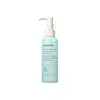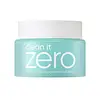What's inside
What's inside
 Key Ingredients
Key Ingredients

 Benefits
Benefits

 Concerns
Concerns

 Ingredients Side-by-side
Ingredients Side-by-side

Water
Skin ConditioningDipropylene Glycol
HumectantPEG-15 Glyceryl Isostearate
EmulsifyingPEG-20 Glyceryl Triisostearate
EmollientBis-PEG-18 Methyl Ether Dimethyl Silane
EmollientButylene Glycol
HumectantPEG/PPG/Polybutylene Glycol-8/5/3 Glycerin
HumectantPolysorbate 20
EmulsifyingParfum
MaskingTorreya Nucifera Seed Oil
EmollientPhenoxyethanol
PreservativeDisodium EDTA
Ethylhexylglycerin
Skin ConditioningTocopherol
AntioxidantRosa Centifolia Flower Extract
AstringentSalicylic Acid
MaskingBHT
AntioxidantWater, Dipropylene Glycol, PEG-15 Glyceryl Isostearate, PEG-20 Glyceryl Triisostearate, Bis-PEG-18 Methyl Ether Dimethyl Silane, Butylene Glycol, PEG/PPG/Polybutylene Glycol-8/5/3 Glycerin, Polysorbate 20, Parfum, Torreya Nucifera Seed Oil, Phenoxyethanol, Disodium EDTA, Ethylhexylglycerin, Tocopherol, Rosa Centifolia Flower Extract, Salicylic Acid, BHT
Cetyl Ethylhexanoate
EmollientPEG-20 Glyceryl Triisostearate
EmollientPEG-10 Isostearate
EmulsifyingSynthetic Wax
AbrasivePhenoxyethanol
PreservativeButylene Glycol
HumectantParfum
MaskingVitis Vinifera Seed Oil
EmollientOlea Europaea Fruit Oil
MaskingTocopheryl Acetate
AntioxidantWater
Skin ConditioningEthylhexylglycerin
Skin ConditioningThuja Orientalis Leaf Extract
AntioxidantPropanediol
SolventZanthoxylum Piperitum Fruit Extract
Skin ConditioningCarthamus Tinctorius Flower Extract
Skin ConditioningDextrin
AbsorbentGardenia Florida Fruit Extract
Skin ConditioningVitis Vinifera Root Extract
Skin ConditioningVitis Vinifera Vine Extract
Skin Conditioning1,2-Hexanediol
Skin ConditioningBambusa Vulgaris Leaf/Stem Extract
HumectantAspalathus Linearis Extract
Skin ConditioningAngelica Archangelica Root Extract
MaskingMalpighia Glabra Fruit Extract
Skin ConditioningResveratrol
AntioxidantPolydiethyleneglycol Adipate/Ipdi Copolymer
Acrylates/Ammonium Methacrylate Copolymer
Acrylates/Methoxy PEG-15 Methacrylate Copolymer
Cetyl Ethylhexanoate, PEG-20 Glyceryl Triisostearate, PEG-10 Isostearate, Synthetic Wax, Phenoxyethanol, Butylene Glycol, Parfum, Vitis Vinifera Seed Oil, Olea Europaea Fruit Oil, Tocopheryl Acetate, Water, Ethylhexylglycerin, Thuja Orientalis Leaf Extract, Propanediol, Zanthoxylum Piperitum Fruit Extract, Carthamus Tinctorius Flower Extract, Dextrin, Gardenia Florida Fruit Extract, Vitis Vinifera Root Extract, Vitis Vinifera Vine Extract, 1,2-Hexanediol, Bambusa Vulgaris Leaf/Stem Extract, Aspalathus Linearis Extract, Angelica Archangelica Root Extract, Malpighia Glabra Fruit Extract, Resveratrol, Polydiethyleneglycol Adipate/Ipdi Copolymer, Acrylates/Ammonium Methacrylate Copolymer, Acrylates/Methoxy PEG-15 Methacrylate Copolymer
 Reviews
Reviews

Ingredients Explained
These ingredients are found in both products.
Ingredients higher up in an ingredient list are typically present in a larger amount.
Butylene Glycol (or BG) is used within cosmetic products for a few different reasons:
Overall, Butylene Glycol is a safe and well-rounded ingredient that works well with other ingredients.
Though this ingredient works well with most skin types, some people with sensitive skin may experience a reaction such as allergic rashes, closed comedones, or itchiness.
Learn more about Butylene GlycolEthylhexylglycerin (we can't pronounce this either) is commonly used as a preservative and skin softener. It is derived from glyceryl.
You might see Ethylhexylglycerin often paired with other preservatives such as phenoxyethanol. Ethylhexylglycerin has been found to increase the effectiveness of these other preservatives.
Parfum is a catch-all term for an ingredient or more that is used to give a scent to products.
Also called "fragrance", this ingredient can be a blend of hundreds of chemicals or plant oils. This means every product with "fragrance" or "parfum" in the ingredients list is a different mixture.
For instance, Habanolide is a proprietary trade name for a specific aroma chemical. When used as a fragrance ingredient in cosmetics, most aroma chemicals fall under the broad labeling category of “FRAGRANCE” or “PARFUM” according to EU and US regulations.
The term 'parfum' or 'fragrance' is not regulated in many countries. In many cases, it is up to the brand to define this term.
For instance, many brands choose to label themselves as "fragrance-free" because they are not using synthetic fragrances. However, their products may still contain ingredients such as essential oils that are considered a fragrance by INCI standards.
One example is Calendula flower extract. Calendula is an essential oil that still imparts a scent or 'fragrance'.
Depending on the blend, the ingredients in the mixture can cause allergies and sensitivities on the skin. Some ingredients that are known EU allergens include linalool and citronellol.
Parfum can also be used to mask or cover an unpleasant scent.
The bottom line is: not all fragrances/parfum/ingredients are created equally. If you are worried about fragrances, we recommend taking a closer look at an ingredient. And of course, we always recommend speaking with a professional.
Learn more about ParfumPeg-20 Glyceryl Triisostearate comes from Isostearic Acid and glycerin.
It is an emollient, emulsifier, and gentle cleanser. As an emollient, it helps trap moisture to keep skin soft and hydrated. Emulsifiers help prevent ingredients from separating.
This ingredient is common in oil-based products. This is because it helps oil-ingredients be easily washed away without leaving a residue.
Peg-20 Glyceryl Triisostearate may not be fungal-acne safe.
Learn more about PEG-20 Glyceryl TriisostearatePhenoxyethanol is a preservative that has germicide, antimicrobial, and aromatic properties. Studies show that phenoxyethanol can prevent microbial growth. By itself, it has a scent that is similar to that of a rose.
It's often used in formulations along with Caprylyl Glycol to preserve the shelf life of products.
Water. It's the most common cosmetic ingredient of all. You'll usually see it at the top of ingredient lists, meaning that it makes up the largest part of the product.
So why is it so popular? Water most often acts as a solvent - this means that it helps dissolve other ingredients into the formulation.
You'll also recognize water as that liquid we all need to stay alive. If you see this, drink a glass of water. Stay hydrated!
Learn more about Water